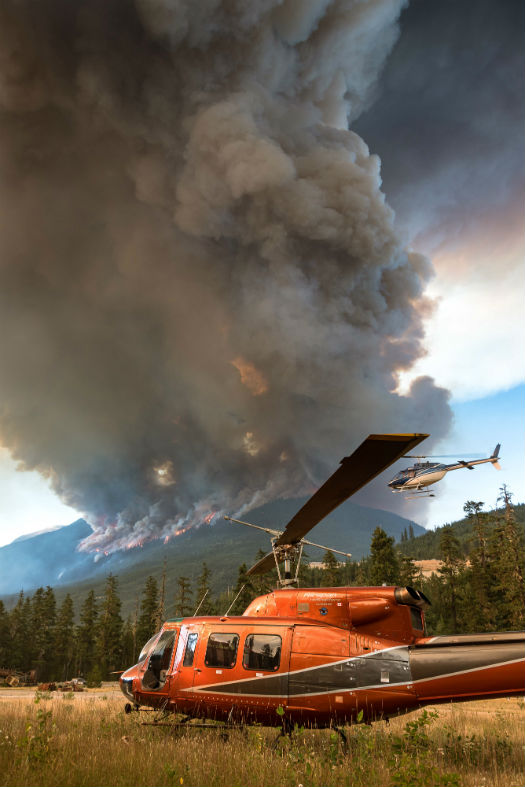
Airspan Helicopters and Blackcomb Aviation are just two operators committed to fighting fires in Western Canada. Shawn Evans Photo
As severe wildfires rage across Western Canada, hundreds of helicopters from across the country are being deployed to help combat the flames. Canada has already seen almost double the number of wildfires in 2015 than across the whole of 2014 (4,921 as compared to 2,429), and the need for rotary-wing firefighting support has provided a much-needed shot in the arm for utility operators across the nation.
According to the Canadian Interagency Forest Fire Centre Inc., there have been up to about 400 helicopters on casual hire fighting 455 blazes across the country, with most concentrated in Saskatchewan, British Columbia, and Alberta.
Northern Saskatchewan has been one of the regions hit hardest by the fires, with over 13,000 people evacuated to more southern cities. A large portion of evacuees came from the town of La Ronge, Sask., home to Helicopter Transport Services Canada (HTSC), an operator with bases spanning Canada and the United States. When a state of emergency was declared for the region, the owner of HTSC jumped into action to help save the town that many of his employees call home.

Helicopters and pilots from HTSC’s base in La Ronge, Sask., have been conducting firefighting operations to protect their home town. HTSC Photo
“He ordered that we take the [Sikorsky CH-54B] Skycrane helitanker that we had parked during a crew change, [and] just said, ‘Look, pick it up, get it up there, put it on fires, and we’ll pay for the fuel, and there’s no charge for the mobilization and demobilization,’ ” said Mike Lavoy, HTSC vice president marketing and communications. “It’s about a $300,000 value . . . ‘just get it up there.’ “
The Skycrane, normally based in Aurora, Ore., has now entered operations in Saskatchewan, joining another 12 of the company’s helicopters in fighting the blazes. The Skycrane is owned by HTSC’s American sister company, Helicopter Transport Services, and holds up to 2,600 gallons of water.
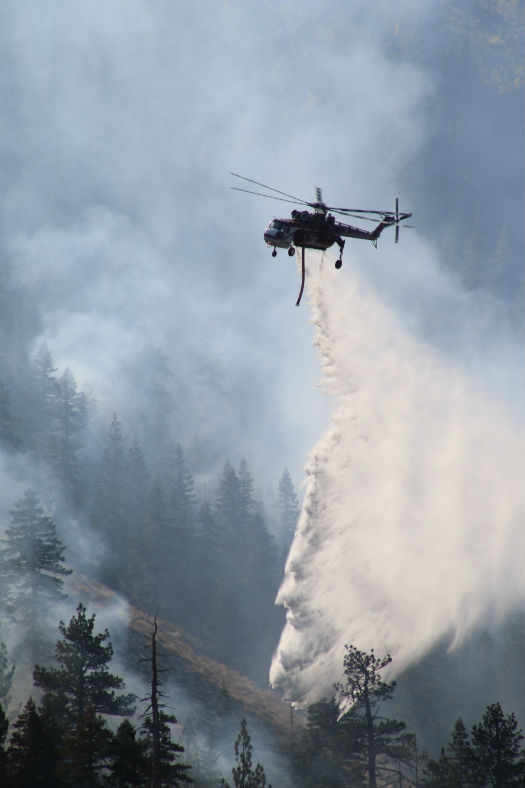
HTSC’s American sister company, Helicopter Transport Services, sent a Sikorsky CH-54B Skycrane to Saskatchewan to help fight wildfires. HTSC Photo
HTSC has about 25 people working the fires, staying in their home of La Ronge, even though their families have already been evacuated. They have joined forces with firefighters from the Saskatchewan Department of Environment and Resource Management, or SERM, to protect the town. The company’s headquarters has not been damaged, but all of its aircraft have been relocated to the town’s airport, which Lavoy said is the “safest place in La Ronge.”
Fires in British Columbia have also been burning abnormally early this season. There are currently 148 fires burning in B.C., where helicopter operators are working all hands on deck. Wildcat Helicopters of Kelowna, B.C., has 20 staff members and its entire fleet of helicopters — five Bell 412s and five Bell 212s — fighting the fires.
The operator employs the rapattack technique with two of its Bell 412 helicopters, rappelling crew members into areas that are inaccessible to other conventional aircraft.
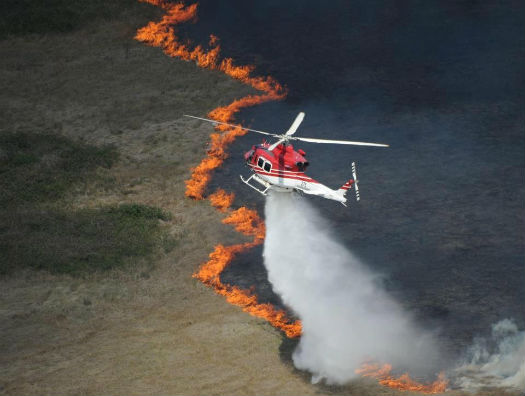
Wildcat Helicopters is completely dedicated to fire fighting operations with a fleet of Bell 412 and 212 helicopters. Wildcat Helicopters Photo
“The way the aircraft is equipped allows for the deployment of the crew, and then allows the aircraft to immediately go into action attacking the fire through the use of the Fire Attack Heli tank,” explained Ian Wilson, vice president of Wildcat Helicopters.
With the fire season still in its infancy, business for companies like Wildcat is booming, and is not predicted to slow down.
“All we do is fires. It’s about making a difference, saving personal and industry assets,” said Wilson. “I would foresee this being a very busy fire year for all of the operators and a lot of the provinces all at once.”
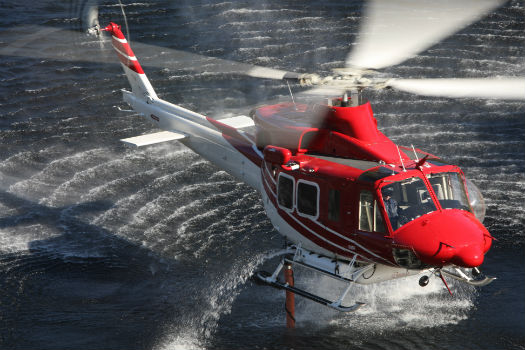
Wildcat Helicopters conducts firefighting operations using techniques including tanking and rapattack. Wildcat Helicopters Photo
Although B.C. and Saskatchewan have been the center of media attention regarding fires this season, Alberta was the first province to be hit, and has the second highest number of fires burning province-wide (103).
Paul Spring, Phoenix Heli-Flight president and operations manager, said that because of the early need for helicopters in Alberta, other provinces may be struggling to find the necessary resources to fight their fires.
“By the time Saskatchewan started hiring and B.C. started hiring, a lot of the assets had already gone to Alberta,” he said. “You can get caught behind the hiring curve if your fires come second or third . . . and everyone’s working in Alberta already. Most of them won’t pull a machine off a fire to move to another fire.”
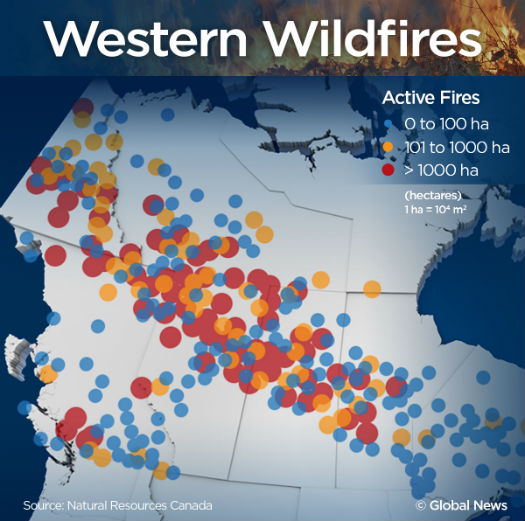
Global News/Natural Resources Canada Image
Phoenix Heli-Flight performs a wide variety of missions, so the company has split its fleet between normal industry work and firefighting; despite the high demand for firefighting machines, Spring explains he needs to remain committed to his industry customer base around Fort McMurray.
“We can never give the entire fleet to forestry, because forestry is seasonal work and you never know if it’s going to happen,” he said. “The other customers use us year round, rain or shine, so you have to be loyal to those people. Unless the fire is right where they’re working, their work continues.”
Although the harsh fire season has been difficult for residents, helicopter operators are relieved to see business picking up. Many operators in Canada rely on the fire season to generate demand for their fleets.
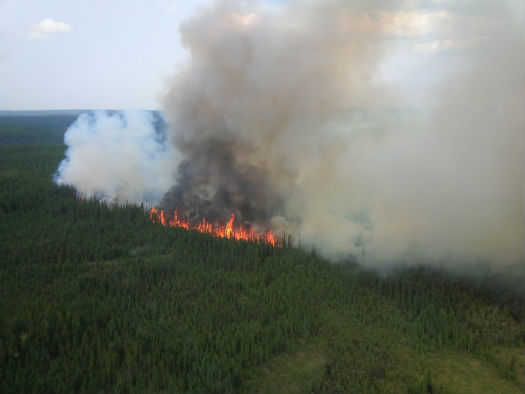
Pictured above, and taken from a Phoenix Heli-Flight AS350 B2 helicopter, fire MWF 114 shortly after it was started by lightning. Spring explains that all aircraft were forced off the fire by another thunderstorm. The fire eventually grew to over 14,000 hectors. Phoenix Heli-Flight Photo
“Economic wise, many helicopter companies have been hanging on the last few years hoping for a big fire just to stay alive,” explained Spring. “This will, for a lot of those companies that were marginally successful financially, see them through probably for another couple years.”
Logistically, the Western provinces have been required to bring in a variety of fixed-wing and rotary-wing aircraft, as well as pilots from out of the province — and from out of the country. With foreign pilots working in the same space as local pilots, partnership becomes critical, and crews need to be on high alert for any aircraft that could be creating an unsafe environment. Spring explains that with low visibility and only a short amount of time dedicated to flight planning, the risk factor on these flights is heightened.
“You get everyone flying around [at] low level with buckets and long line buckets trying to fight fires, and it’s pretty easy to get to the wrong fire, because you can’t tell and some of them are very close,” he said. “So you get to the wrong fire, that means you’re on the wrong channel.

High risk results in high reward for Canadian firefighting pilots. Shawn Evans Photo
“You may make a call that you’re there but nobody on that fire hears you, so you fly into a very active zone and nobody knows you’re coming. If you can pull it all together and do it well it’s hugely rewarding, and the camaraderie builds quickly with your crews.”
The high risk factor brings a high reward for firefighting pilots, especially when working locally to save their own community. With a long fire season still looming, the companies involved in firefighting operations are fully committed to the serious mission ahead, explains HTSC’s Lavoy.
“Our job is to keep the town safe, because we all have homes there and we all have businesses there, and people outside of the area are very worried about their homes,” he said. “We’re staying there until we can stop all of this.”
Editor’s note: Sunday, July 12, a Bell 412 helicopter operated by Wildcat Helicopters crashed near Slave Lake, Alta., during firefighting operations. The pilot survived the crash and was taken to hospital with non life-threatening injuries. The Transportation Safety Board of Canada is investigating the cause of the crash.





